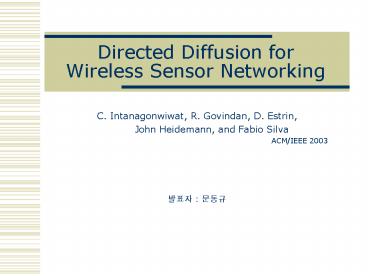Directed Diffusion for Wireless Sensor Networking PowerPoint PPT Presentation
1 / 21
Title: Directed Diffusion for Wireless Sensor Networking
1
Directed Diffusion for Wireless Sensor Networking
- C. Intanagonwiwat, R. Govindan, D. Estrin,
- John Heidemann, and Fabio Silva
- ACM/IEEE 2003
- ??? ???
2
Sensor Network Structure
- Sensor field ?? ???? ??? ??
- Sink ????? ???? ??
- Event ??? ????? ??
3
Contents
- Introduction
- Directed Diffusion
- Simplified schematic for Directed Diffusion
- Data Naming
- Interest Gradient
- Interest Propagation
- Data Propagation
- Reinforcement
- Simulations
- Conclusion
4
Introduction (1/2)
- Wireless sensor networks
- Sensing devices with communication capability
- Event monitoring
- Enemy detection, aircraft interiors, large
industrial plants - Data-centric communication
- Data is named by attribute-value
- Different form IP-style communication
- End-to-end delivery service
A sensor field
Sources
Event
Sink Node
5
Introduction (2/2)
- Data-centric communication (cont.)
- Human operators query (task) is diffused
- Sensors begin collecting information about query
- Information returns along the reverse path
- Intermediate nodes aggregate the data
- Combing reports from sensors
- Challenges
- Scalability
- Energy efficiency
- Robustness / Fault tolerance in outdoor areas
- Efficient routing
6
Simplified schematic for Directed Diffusion
- (a) Sink? Interest ???? ??? ??
- (b) ??? ??? ?? ????
- (c) ??? ??
- (d) ??? ???? ??
7
Data Naming
- Content based naming
- Task are named Attribute value pair
- Selecting naming scheme important
- No globally unique ID for nodes only locally
unique
Reply Data type four-legged animal
interval 1s rect -100,100,200,200
timestamp 012040 expiresAt 013040
Request Interest type four-legged animal
interval 20 ms duration 10 seconds
rect -100,100,200,200
8
Interest Gradient
- Interest describes a task needed to be done by
the sensor network - Interests are injected into the network at sink.
- Sink broadcasts the interest.
- Interval specifies an event data rate.
- Initially, requested interval much larger than
needed. - Node maintains an interest cache.
- Interest entry also maintains gradients.
- Specifies a data rate and a direction (neighbor)
- Data flows from the source to the sink along the
gradient
9
Interest Propagation
- Flooding
- Constrained or Directional flooding based on
location. - Directional Propagation based on previously
cached data.
Gradient
Source
Interest
Sink
10
Data Propagation
- Reinforcement to single path delivery.
- Multipath delivery with probabilistic forwarding.
- Multipath delivery with selective quality along
different paths.
Gradient
Source
Data
Sink
11
Reinforcement
- Reinforce one of the neighbor after receiving
initial data. - Neighbor(s) from whom new events received.
- Neighbor whos consistently performing better
than others. - Neighbor from whom most events received.
Gradient
Source
Data
Reinforcement
Sink
12
Negative Reinforcement(1/2)
- Explicitly degrade the path by re-sending
interest with lower data rate. - Time out
Gradient
Source
Data
Reinforcement
Sink
13
Negative Reinforcement(2/2)
- Using negative reinforcement
- Path Truncation
- Loop removal
- For resource saving
- B negative reinforces D, D negative reinforces E,
14
Performance Evaluation (1/7)
- Simulator ns-2
- Network Size 50-250 Nodes
- Transmission Range 40m
- Constant Density 1.95x10-3 nodes/m2 (9.8 nodes
in radius) - MAC Modified Contention-based MAC
- Transceiver Energy Model mimics a sensor radio
- 660 mW in transmission, 395 mW in reception, and
35 mW in idle - Comparison with
- Flooding
- Omniscient multicast
15
Performance Evaluation (2/7)
- Average dissipated energy
0.018
0.016
Flooding
0.014
0.012
0.01
0.008
(Joules/Node/Received Event)
Omniscient Multicast
Average Dissipated Energy
0.006
Diffusion
0.004
Due to the data-aggregation Nodes suppress
duplicate location estimates
0.002
0
0
50
100
150
200
250
300
Network Size
16
Performance Evaluation (3/7)
- Average delay
0.35
0.3
Flooding
0.25
0.2
Average Delay (secs)
0.15
0.1
Omniscient Multicast
Diffusion
0.05
0
Uncongested sensor network Reinforcement rules
find the low delay path
0
50
100
150
200
250
300
Network Size
17
Performance Evaluation (4/7)
- Impact of dynamics (Distinct event delivery
ratio)
18
Performance Evaluation (5/7)
- Impact of negative reinforcement
19
Performance Evaluation (6/7)
- Impact of duplicate suppression
Negative reinforcement
Suppress identical data sent
20
Performance Evaluation (7/7)
- High idle radio power
21
Conclusion
- Application-level data dissemination has the
potential to improve energy efficiency
significantly - Data-centric dissemination
- Reinforcement based adaptation of paths
- Duplicate suppression and aggregation
- MAC for sensor networks needs to be designed
carefully.

